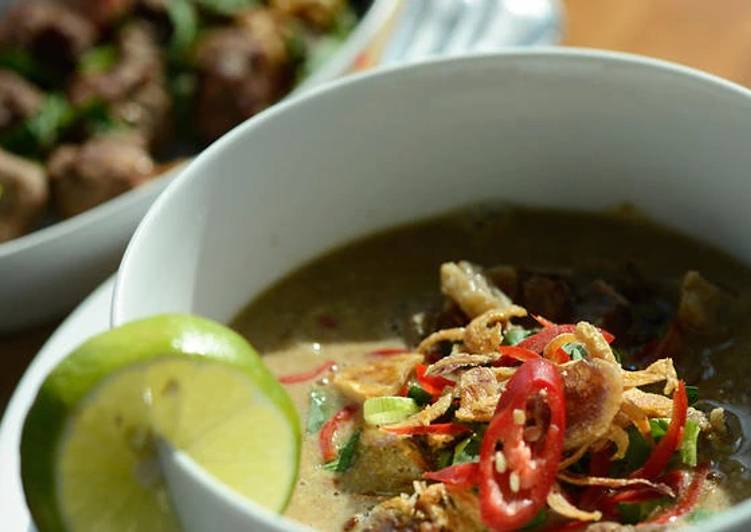
Hey everyone, hope you’re having an amazing day today. Today, we’re going to make a distinctive dish, coto makassar. It is one of my favorites food recipes. This time, I am going to make it a bit unique. This is gonna smell and look delicious.
Coto makassar is one of the most favored of recent trending meals in the world. It’s enjoyed by millions daily. It is easy, it is quick, it tastes delicious. Coto makassar is something that I’ve loved my entire life. They’re nice and they look wonderful.
Coto Makassar or Coto Mangkasara (Makassarese), is an Indonesian traditional soup originating from Makassar, South Sulawesi. It is a variant of soto traditional beef and offal stew with seasoned broth made from ground peanuts and spices. The main ingredient of this soup is beef and it can be mixed with innards such as intestine, liver, lungs, heart, tripe, or cow brain.
To begin with this recipe, we have to prepare a few components. You can have coto makassar using 21 ingredients and 4 steps. Here is how you cook that.
The ingredients needed to make Coto makassar:
- Take 100 gm rice
- Get 500 ml water
- Get pinch salt
- Take pinch sugar
- Prepare 250 gm beef mince
- Take 100 gm cooked oxtail meat, shredded
- Make ready 1 tbsp white pepper
- Take 1 pinch nutmeg
- Take 1 tbsp coriander seeds, roasted & ground
- Make ready 2 egg, whites separated
- Prepare 50 ml vegetable oil
- Prepare 4 tbsp galangal (dried)
- Take 4 tbsp lemongrass (dried)
- Make ready 1 tbsp crushed garlic
- Make ready 40 ml coconut milk
- Take 1 L beef stock
- Get garnish
- Prepare lime slices or wedges
- Make ready fried shallots
- Prepare 1 long red chilli, finely sliced
- Take spring onions, sliced
Hidangan Coto Makassar ini, lebih cocok disantap dengan ketupat maupun lontong. Menu andalan yang disediakan untuk para tamu di momentum lebaran tersebut ialah Coto Makassar. Makassar is one of Indonesia's most famous culinary destinations. This port city situated at the south of Sulawesi Island is represented in the most traditional dish of the area - coto Makassar.
Steps to make Coto makassar:
- Soak the rice in water with a pinch of salt and sugar for 30 minutes and drain, reserving the starchy water.
- To make the meatballs, add the mince meat and cooked oxtail in a bowl and season with salt, to taste, and the white pepper. Mix with nutmeg, 2 teaspoons of the ground coriander seeds and egg whites. Roll tablespoons of the mixture into balls and set aside.
- Heat the vegetable oil in a large wok and add the galangal, lemongrass, garlic and the remainder of the ground coriander. Sauté, stirring, for about 2 minutes or until aromatic. Mix the egg yolk with the coconut milk and add to the pan with the starchy rice water. Stir, and add beef stock. Bring to the boil, and simmer for about 4-5 minutes.
- Meanwhile, sear the meatballs in another deep frypan over high heat. Once they’re evenly browned, add the beef stock mixture over the top of the meatballs. Simmer until the meatballs are cooked through, and serve garnished with shallots, lime wedges, spring onions, and red chillies. - - NOTES - - Soaking time: 30 minutes.
This thick and tasty soup is usually made with beef and a variety of innards, such as tripe, brain, lungs, or intestines. Coto Makassar biasanya dibuat dari jeroan sapi yang direbus lama dan campuran daging sapi lainnya, lalu dicampurkan ke dalam racikan bumbu rempah yang khas. Bukan hanya itu, olahan jeroan dan daging sapi tersebut kemudian dicampurkan dengan kuah santan gurih yang menyegarkan. Coto Makassar ini semakin nikmat disantap dengan ketupat atau buras. Coto Makassar atau coto Mangkasara merupakan makanan tradisonal Makassar, Sulawesi Selatan.
So that’s going to wrap it up for this special food coto makassar recipe. Thank you very much for reading. I am sure that you can make this at home. There is gonna be more interesting food at home recipes coming up. Remember to save this page in your browser, and share it to your loved ones, friends and colleague. Thanks again for reading. Go on get cooking!


